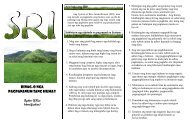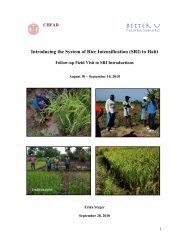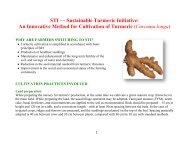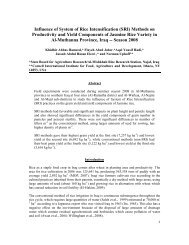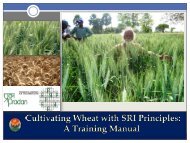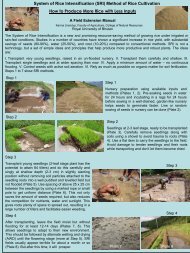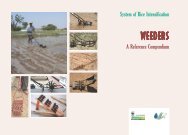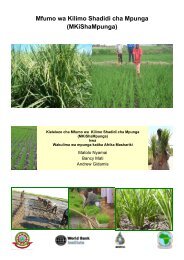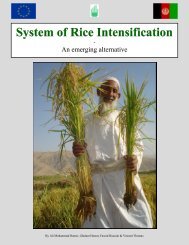EFFECT OF THE SYSTEM OF RICE INTENSIFICATION (SRI) ON ...
EFFECT OF THE SYSTEM OF RICE INTENSIFICATION (SRI) ON ...
EFFECT OF THE SYSTEM OF RICE INTENSIFICATION (SRI) ON ...
Create successful ePaper yourself
Turn your PDF publications into a flip-book with our unique Google optimized e-Paper software.
the process of puddling – which is also the purpose (Greenland, 1997). Puddling is a process,<br />
initiated before transplanting/seeding rice, where fields are flooded and then harrowed or ploughed<br />
resulting in a decrease of the aggregate stability due to both a wetting and mechanical intervention<br />
of the aggregates (De Datta & Hundal, 1984). Puddling is used in order to prevent loss of water<br />
from e.g. percolation on especially alluvial and mountain soils, to level the fields and make it easier<br />
to transplant rice seedlings (Greenland, 1997).<br />
When OM is decomposed nutrients are mineralized and thereby increasing soil fertility (Larson &<br />
Clapp, 1984). But in submerged conditions decomposition is very slow and mineralization is<br />
therefore slowed down as well and nutrient availability might therefore be decreased. The most<br />
important effect of adding composts to rice fields is to increase available N and to balance the<br />
immobilization and mineralization of N found in the soil (Kumazama, 1984).<br />
Nutrients will though not be available to plants before a decomposition of the OM sets in and the<br />
OM is mineralized and releases inorganic nutrient ions in available forms to plants (Brady & Weil,<br />
1999a). Fresh OM inputs should be avoided such as fresh rice straw as larger amounts applied to<br />
fields will result in N-immobilization and a high reduction of the soil and should like all other fresh<br />
OM be composted in order to reach a higher level of efficiency (Inoko, 1984). If large amounts of<br />
fresh OM inputs are applied , it is possible that the soil will be further reduced and produce GHGs<br />
(Greenland, 1997). These risks will be introduced in chapter 3. Submerged soils normally<br />
mineralize higher amounts of N as less is immobilized compared to aerobic soils even if<br />
decomposition of OM is slower (De Datta, 1987).<br />
2.3 Storing of C in soils<br />
The content of SOM depends on the equilibrium between losses of C and gains of C from mainly<br />
respiration, erosion, removal of plant residues, plant growth in situ and applications of organic<br />
inputs respectively (Brady & Weil, 1999a). The key issue is to apply enough inputs of high quality<br />
materials in order to maintain the C content at equilibrium or slowly increase its content.<br />
2.4.1 Ways of increasing C in soils through management<br />
Many studies have identified possible management methods which can alter the C content in a soil<br />
hence affecting the OM content. However, most studies relate to aerobic field conditions.<br />
15



